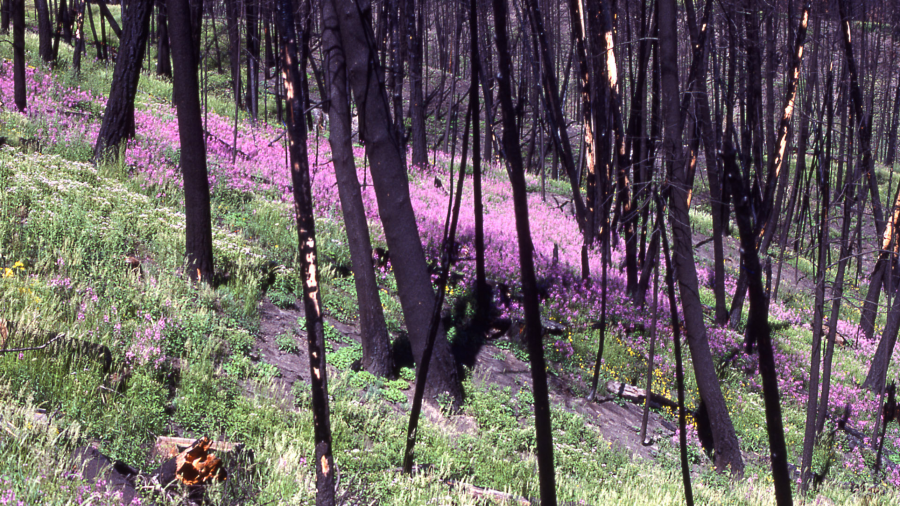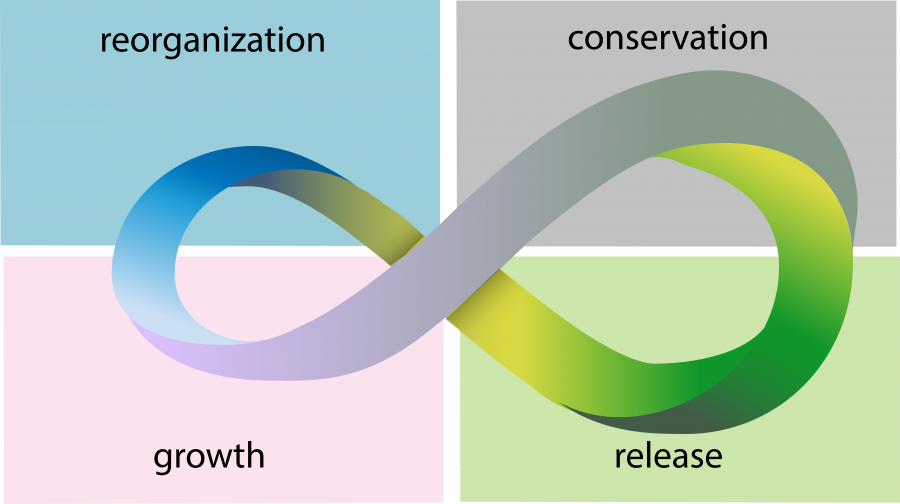
Photo credit: Jim Peaco (1988) via Wikimedia Commons.
To view in your browser and/or download the article, click on the PDF below.
The state of a social-environmental system is assumed to exist within some dynamic equilibrium—it is not static, but its variability is not so great that it must be described quite differently. In other words, it fluctuates in time and space but is resilient to modest perturbations.1 However, if social or environmental perturbations are large enough, the system can dramatically change—sometimes collapsing from a social and ecological perspective. This change can be irreversible if the system fails to adapt; however, the ability to diversify and innovate can lead to recovery as described in the following example.
In the early 1900s, U.S. steel production dominated the global market, but the industry did not readily adopt new technologies that took hold internationally. Thus, by the late 1970s, U.S. plants closed, people lost their jobs, and communities were devastated. People in cities like Youngstown, Ohio, and Pittsburgh, Pennsylvania, suffered greatly—infrastructure decayed, environments experienced contamination, and a lack of jobs led to poverty and migration to other places. Today, Youngstown remains a shrinking city (Figure 1, left). In contrast, Pittsburgh has experienced major renewal as its leaders embraced change, economic diversification, and environmental cleanup (Figure 1, right). Both cities underwent dramatic socio-environmental change, but one illustrates adaptive resilience—Pittsburgh invested in change and reorganized in ways that improved the environment and human well-being for many (but not all2).

Theory of Socio-Environmental Reorganization
The cycle of reorganization that the above example typifies falls under what has been described as panarchy—a term first applied by Lance Gunderson and C.S. Holling in 2002.3 They wrote, “…panarchy describes how a healthy system can invent and experiment, benefiting from inventions that create opportunity while being kept safe from those that destabilize because of their nature or excessive exuberance.” The cycle represents four different phases (states) that the system goes through after it experiences significant perturbation. Put very simplistically, the system undergoes “growth” as resources are exploited; it matures over time into a “conservation” state (meaning it is relatively stable) as interactions and connections among its components grow; the system then collapses or undergoes “release” due to changes in those interactions caused by some perturbation that crosses a threshold. Finally, over time, the system reorganizes or renews depending on its resilience capacity.

Returning to the steel industry example and drawing on Brian Walker’s and David Salts’ explanation of “Resilience Thinking,”4 the following illustrates a version of these phases:
- The growth phase corresponded to the period when Ohio's and Pennsylvania’s industries grew dramatically, benefiting from abundant coal and access to rivers for transportation.
- In the conservation phase, the cities became increasingly specialized socioeconomically because people and institutions associated with the steel industry and its resources grew more connected and became competitively superior. Because efficiency can increase with scale, plants grew bigger with smaller costs per unit, and processes and modes of operation became more standardized (“regulated”). However, this meant the system was more rigid, and its lack of flexibility (e.g., to technological innovation and changing labor issues) translated to low resilience capacity.
- The rapid growth and superior competition of international steel makers was a “shock” to the system, which resulted in breaks to the connections‚ e.g., coal demand decreased, so coal miners lost jobs. Thus the collapse or “release” phase occurs as natural, social, and economic capital leaked out of the system.
- Only with new capital—as in the case of Pittsburgh’s investments in and social willingness to change—does such a system enter the reorganization phase and renews itself.
The analogy for an ecological system is growth that occurs as pioneer species move into a new resource-rich habitat. They exploit all available niches and prosper (“r strategists”). Over time, interactions and connections between species and their use of resources increase, those species that can specialize and out-compete pioneer species take hold. They expand their distributions over larger areas and persist for much longer than pioneers. When some disturbance occurs (e.g., floods, fire, or disease outbreak), mortality is high, and resources become available (“renewed”) for new species to recruit and thrive under the new conditions. The system has reorganized.
Examples of the panarchy cycle for socio-environmental systems are growing in the literature,5, 6 but what is of most interest today is how to apply resilience and reorganization theory to the management of socio-environmental systems.7, 8 Can we detect when systems are approaching a threshold, so steps can be taken to avoid collapse? Can we manage social and environmental systems for resilience so that they can adapt and reorganize in ways that benefit humans and their environments? What role does resilience theory play in sustainability challenges, such as climate change and human vulnerability to its impacts?
References:
1 Holling, C.S. (1973). Resilience and stability of ecological systems. Annual Review of Ecology and Systematics. 4, 1–23. https://www.annualreviews.org/doi/abs/10.1146/annurev.es.04.110173.000245
2 Deitrick, S., & Briem, C., (2022). Quality of life and demographic-racial dimensions of differences in most liveable Pittsburgh. Journal of Urban Regeneration & Renewal, 15(2), 193-209. https://doi.org/10.1146/annurev.es.04.110173.000245
3 Gunderson, L.H., & Holling, C.S. (2002). (Eds.) Panarchy: Understanding Transformations in Human and Natural Systems. Island Press.
4 Walker, B. & Salt, D. (2006). Resilience Thinking: Sustaining Ecosystems and People in a Changing World. Island Press.
5 Whitfield, S., Beauchamp, E., Boyd, D.S., Burslem, D., Byg, A., Colledge, F., Cutler, M.E., Didena, M., Dougill, A., Foody, G., & Godbold, J.A. (2019). Exploring temporality in socio-ecological resilience through experiences of the 2015-16 El Niño across the Tropics. Global Environmental Change, 55, 1-14. https://doi.org/10.1016/j.gloenvcha.2019.01.004
6 Yang, Y., Fang, Y., Xu, Y., & Zhang, Y. (2021). Assessment of urban resilience based on the transformation of resource-based cities: a case study of Panzhihua, China. Ecology & Society, 26(2), 20. https://doi.org/10.5751/ES-12280-260220
7 Barrett, C.B., & Constas, M.A. (2014). Toward a theory of resilience for international development applications. Proceedings of the National Academy of Sciences, 14: 14625–14630. www.pnas.org/cgi/doi/10.1073/pnas.1320880111
8 Woods, P.J., Macdonald, J.I., Bárðarson, H., Bonanomi, S., Boonstra, W.J., Cornell, G., Cripps, G., Danielsen, R., Färber, L., Ferreira, A., & Ferguson, K. (2022). A review of adaptation options in fisheries management to support resilience & transition under socio-ecological change. ICES Journal of Marine Science, 79(2), 463-479. https://doi.org/10.1093/icesjms/fsab146